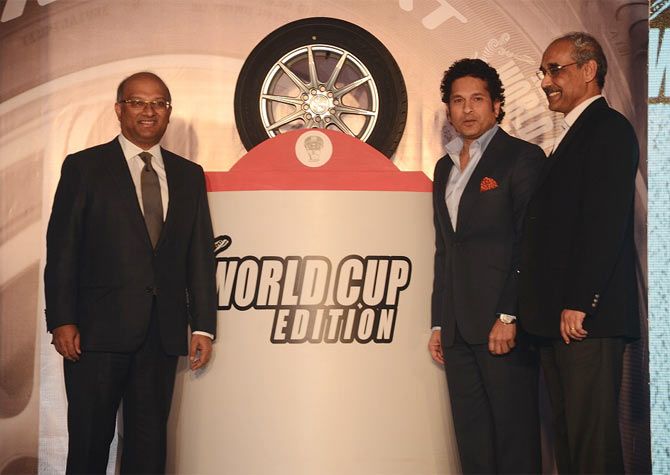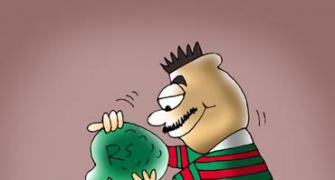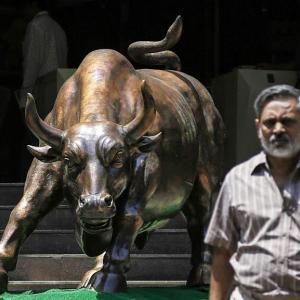Chennai-based MRF’s stock has soared more than 100 times since 2001, but high input costs and cheap imports could slow down its forward march, says T E Narasimhan.

Image: Cricketer Sachin Tendulkar flanked by Arun Mammen, MD, MRF LTD, and Koshy K Varghese, EVP-Marketing, MRF LTD, at the launch of MRF’S ZSPORT, a special World Cup 2015 edition tyre, in Mumbai on February 7, 2015.
At the end of the trading day on September 28, MRF made history: it became the most valuable stock in the country, dethroning Orissa Minerals Development Company, whose stock has plummeted from the heights reached in 2010.
As MRF’s share crossed the Rs 50,000-mark, it soared more than 100 times since 2001, when it was valued at Rs 500. Until Monday’s close, the share was holding steady at over Rs 53,000. Analysts say the company’s forward march is likely to continue as the demand for automobiles -- and in turn for tyres -- is set to rise on the back of a good monsoon this year.
From a balloon manufacturer in a rundown shed to the country’s most valuable stock, MRF’s journey has been nothing short of startling. The company was set up by K M Mammen Mappillai, the son of an affluent businessman in Kerala, in 1946. However, Mappillai wasn’t a typical entrepreneur from a rich family who was starting small.
The venture came about at a time when his family’s assets and businesses were confiscated by the king of Travancore and his father, K C Mammen Mappillai, was jailed for participating in the freedom movement.
After a hardscrabble existence that saw Mappillai carrying the balloons in bags to markets and selling them himself, the turning point came in 1954 when he graduated to manufacturing tread rubber, or the outer layer of radials. Thereafter, it was one milestone after another for MRF: it went public in 1961; started manufacturing tyres in 1962; began exports to the US in 1964; and introduced nylon radials in India in 1973.
In 2007, it reached $1 billion in turnover, and over the next four years went on to double it. In 2015-16, even as automobile sales slowed globally, MRF’s revenue rose to Rs 20,243.94 crore, from Rs 13,197.58 crore in October 2014 (it had an extended financial period from October 2014 to March 2016.)
The winning strategy
The linchpin of Mappillai’s plan was to focus on exports, incorporate new technology wherever required and find new ways to connect with customers -- strategies that MRF has stayed true to this day.
The focus on research and development (R&D) has given the company an edge when it comes to supplying specialised tyres -- like those for aircraft or fighter jets -- and has opened up new avenues for revenue. Currently, it is the only Indian tyre supplier for Sukhoi 30 MKI series of fighter planes. For aircraft, sourcing tyres locally has an advantage; MRF’s tyres cost Rs 50,000 apiece as against Rs 1.50 lakh for imported ones.
While MRF did not respond to a request for interview from Business Standard, analysts attribute the company’s success to two things: R&D and commercials with themes revolving around sports or patriotism that helped create an emotional connection with people.
Addressing the company’s shareholders’ meet in August, K M Mammen, CMD, MRF, said: “MRF’s wide network, brand dominance and product superiority are the main reasons for its continued customer preference in the market. This was recognised by our peers when we were featured on the Forbes India Super 50 list of India’s most valuable brands.”
Yet, analysts are not painting an overly optimistic picture of the future. They say the onslaught of cheap imports of truck radials from China, the capacity addition by domestic players and the overall slowdown in auto sales could hurt growth going forward.
So far, MRF has managed to stay ahead of the competition because of its entrenched position in the replacement and the two-wheeler market. As much as 76 per cent of the company’s top line is attributed to the tyre-replacement market, where profit margins are better than the original equipment market. Given the steady rise in the number of vehicles on the road, the growth from this area is expected to be robust, but competition is rising in the two-wheeler market.
Apollo Tyres, for example, has recently forayed into the two-wheeler space, and has charted out an ambitious plan to become the leader in the market by 2020. It already has a strong position in the bus and truck segment and is growing rapidly in the passenger vehicle space where it made its foray in 2000. In the replacement market, too, it has a market share of 16 per cent.
Growth pangs
MRF has resorted to price discounting in the commercial vehicle segment to protect its turf from new players. The price cuts at a time when the rubber prices remain volatile are not giving analysts reasons to cheer. They believe a discounting strategy could hurt growth going forward.
However, others disagree. “Because of its greater efficiency, we expect MRF to be able to protect its margins despite pressure on input costs. Demand (especially rural) due to the good monsoon would enable higher bias capacity utilisation, which in turn would provide a cushion to margins in a scenario of rising rubber prices,” says Mayur Milak, research analyst, Anand Rathi Research.
For now, MRF is banking on its wide range of products and its ability to connect with customers to stay ahead in the game. “It is our understanding of the fast-changing customer needs and our speed-to-market in addressing them with nimbleness that will set us apart from the others in the coming years,” said Mammen at the shareholders’ meet.








